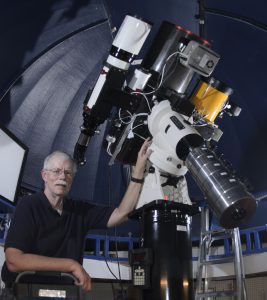UToledo alumnus captured photos featured on new stamp commemorating total solar eclipse
June 13th, 2017 by Christine BillauIn honor of the upcoming total solar eclipse, the U.S. Postal Service is debuting a trailblazing stamp that features two images captured by Fred Espenak, a University of Toledo alumnus and retired NASA astrophysicist affectionately known as Mr. Eclipse.
The Forever Stamp uses thermochromic ink and changes upon touch. With the heat of a finger, Espenak’s photo of the total eclipse of the sun transforms into an image of the full moon, also captured by Espenak.
 “Other countries have used this technology, but it’s the first time in the United States,” Espenak said. “When you rub the stamp, a second image appears from the warmth of your finger. You’ll see the total eclipse of the sun and, with the touch of your finger, you’ll see the full moon.”
“Other countries have used this technology, but it’s the first time in the United States,” Espenak said. “When you rub the stamp, a second image appears from the warmth of your finger. You’ll see the total eclipse of the sun and, with the touch of your finger, you’ll see the full moon.”
On Monday, Aug. 21, a total solar eclipse will be visible from the United States mainland for the first time in 38 years.
“The track of the moon’s shadow will cut diagonally across the nation from Oregon to South Carolina through 14 states,” Espenak said. “Inside the 70-mile-wide path of totality, the moon will completely cover the sun as the landscape is plunged into an unsettling twilight, and the sun’s glorious corona is revealed for more than two minutes.”
 Espenak has had a long career of chasing eclipses around the world. Planes, trains and automobiles have taken Espenak to 27 total eclipses on seven continents.
Espenak has had a long career of chasing eclipses around the world. Planes, trains and automobiles have taken Espenak to 27 total eclipses on seven continents.
Millions have seen his work; Espenak’s photos have been published in National Geographic, Nature and Newsweek.
To commemorate the Aug. 21 event, the Total Eclipse of the Sun Forever stamp will be released Tuesday, June 20, during a ceremony at the University of Wyoming in Laramie. Espenak and his wife will be there.
“I’m honored to have my photographs on a stamp. But more importantly, the stamp will spread the news about America’s Great Eclipse to many more people,” he said. “And what a fantastic opportunity. For a lot of people, this is the chance of a lifetime to see a total eclipse.”
“Fred Espenak is another great example of a ‘rocket scientist’ who has really lived up to that name,” said Dr. Karen Bjorkman, dean of the College of Natural Sciences and Mathematics; Distinguished University Professor of Astronomy; and Helen Luedtke Brooks Endowed Professor of Astronomy. “He has made solid contributions to NASA science missions for many years, and also is doing a wonderful job of sharing his passion for and knowledge of eclipses with the public both on national and international stages. We’re really proud that he is an alumnus of The University of Toledo’s Department of Physics and Astronomy.”
 Espenak will return to his alma mater to speak Thursday, June 15, at 6:30 p.m. in UT’s Memorial Field House Room 2100. He will preview the Great American Total Eclipse on Monday, Aug. 21 that will star the moon passing between the sun and Earth, which will be visible in the contiguous United States for the first time since 1979 — weather permitting.
Espenak will return to his alma mater to speak Thursday, June 15, at 6:30 p.m. in UT’s Memorial Field House Room 2100. He will preview the Great American Total Eclipse on Monday, Aug. 21 that will star the moon passing between the sun and Earth, which will be visible in the contiguous United States for the first time since 1979 — weather permitting.
During the free, public talk funded by the Helen Luedtke Brooks Endowed Professorship in Astronomy, the 1976 UT graduate who received a master of science degree in physics will discuss eclipses and share his eyewitness accounts around the globe through video and photos.
And he’ll offer two words of advice: road trip.
“I’m going to show people what they can expect to see in Toledo and how to watch it using safe eye protection, but I’m also going to encourage people to start making plans for a car trip to the eclipse path of totality because that’s where you have to be to see the total phase of the eclipse, and it’s worth the drive.
“It’s something you remember your entire life because it’s so unusual from anything you’ve seen before,” Espenak said. “The bright sun is completely gone in the sky, and you see this very strange-looking black disc, which is the unilluminated side of the moon, and it’s surrounded by this gossamer, feathery halo that’s the sun’s corona, which is two million degrees. It’s the only time you can see something that’s two million degrees with the naked eye. It’s such a stunning, overwhelming experience: The temperature drops probably 10 degrees as you go into totality, so you feel a chill in the air; animals react strangely; birds quiet down as if they’re going to roost at night.”
Espenak, a retired astrophysicist from NASA’s Goddard Space Flight Center, operates the Bifrost Astronomical Observatory in Portal, Ariz. He is the author of “Eclipse Bulletin: Total Solar Eclipse 2017” and “Road Atlas for the Total Solar Eclipse 2017.”
To view Espenak’s work, go to mreclipse.com.
For more about the commemorative stamp, go to about.usps.com/news/national-releases/2017/pr17_020.htm. The public is asked to share the news on social media using the hashtag #EclipseStamps.
Christine Billau is
UT's Media Relations Specialist. Contact her at 419.530.2077 or christine.billau@utoledo.edu.
Email this author | All posts by
Christine Billau

